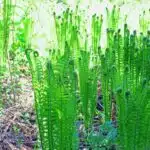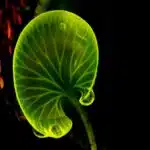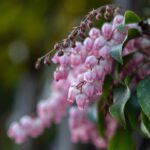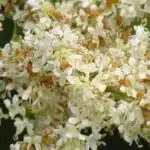Japanese Painted Ferns (Athyrium niponicum var. pictum) are a beautiful, graceful species of fern that can add an elegant and exotic touch to any garden. These hardy plants are easy to care for, and with their lush foliage, they make a spectacular addition to any landscape or container garden. As a specialist in botany and gardening, I am here to share my knowledge on how to grow and care for Japanese Painted Ferns so you can enjoy all the beauty and benefits of these gorgeous plants.
The Japanese Painted Fern is native to Japan, where it has been cultivated for centuries as an ornamental plant. This fern grows in mounds of delicate fronds with silvery white undersides that are highlighted by deep purple-black stems and veins. The striking coloration makes it an excellent choice for adding texture and drama to your garden design. With the right growing conditions and proper care, these ferns will thrive in both outdoor gardens and indoor containers.
When it comes to caring for Japanese Painted Ferns, there are a few important points you should keep in mind. The key is providing the right environment – plenty of indirect sunlight, well-draining soil, adequate moisture levels – while also taking steps to prevent infestations from pests like mealybugs or spider mites. In this article, I will provide detailed advice on how to successfully grow and maintain healthy Japanese Painted Ferns so you can enjoy their beauty for years to come!
Overview Of Japanese Painted Ferns
Japanese Painted Ferns are a sight to behold. These delicate and vibrant plants have long been the subject of admiration for centuries, and for good reason. Not only are they beautiful, but they’re also incredibly resilient – making them perfect for gardeners of all levels.
Like most ferns, Japanese Painted Ferns prefer indirect light and need protection from direct sun. They thrive in moist soil with good drainage, high humidity, and regular misting. To maximize their potential it is important to provide them with adequate nutrition by way of adding a slow-release fertilizer to their potting mix every other month or so.
The foliage of Japanese Painted Ferns can vary in color depending on the variety; some have subtle yellow or bronze accents while others feature deep purple or green hues. Regardless of their shade, its fronds will unfurl gracefully if given the right conditions – making these plants an attractive addition to any outdoor space. With proper care, they can become a showpiece in your garden that will last for years to come!
Growing Conditions
Japanese painted ferns are an exotic sight to behold – their lacy fronds, splashed with deep purple and silver-green, create a magical look in any garden. Growing conditions for these beautiful plants require a bit of finesse but if done right, you’ll be rewarded with a breathtaking display.
When it comes to creating a suitable environment for Japanese painted ferns, it’s important to keep moisture levels consistent. These plants like damp soil but dislike being waterlogged – they prefer soil that is well-draining and slightly acidic. Providing an appropriate amount of humidity is also key – misting the fronds with water daily or placing the container near humidifiers can help your ferns thrive.
Fertilizing your Japanese painted fern is also necessary for its health and vigor. A slow-release fertilizer should be applied twice yearly; this will provide the nutrients that the foliage needs for optimal growth and coloration. Be sure to use a balanced fertilizer and avoid over-applying as this can cause damage to the delicate fronds.
With these tips in mind, you can give your Japanese painted fern all the love and care it needs to flourish in your garden!
Light Requirements
As the sun’s rays caress the delicate fronds of the Japanese Painted Fern, they come alive in vibrant hues of green and purple, highlighted with silver. It’s a sight to behold and one that can be achieved with just the right light requirements.
When it comes to illuminating your fern, there are some things to consider. Firstly, these ferns prefer bright but indirect light throughout most of their growing season. They are not resilient enough to handle direct sunlight and will scorch if exposed too long. However, when provided with a shaded spot or filtered sunlight through an east-facing window, they will thrive with their brightly colored foliage.
During winter months, however, your Japanese Painted Fern may need a bit more light than normal because of its reduced growth rate during this time. A south-facing window is ideal for providing them with enough daylight during this period without overexposing them to strong sunlight. On top of that, fluorescent lights can also be used in order to supplement natural lighting if necessary.
By following these guidelines for lighting needs, you’ll have a healthy and thriving Japanese Painted Fern in no time! Now let’s move on to soil requirements which are essential for successful care of this plant variety.
Soil Requirements
The Japanese painted fern is a beautiful, low-maintenance plant that can provide a lush addition to any garden. It is important, however, to understand and meet the soil requirements for growing this species if you want it to thrive.
In terms of soil type, the Japanese painted fern prefers well-draining soil. A commercial potting mix for ferns or a combination of two parts peat moss and one part perlite works well when planting in containers. If you are planting your fern in an outdoor bed, make sure the soil has plenty of organic matter and is not prone to waterlogging. Amend the soil with sand or other coarse particles if necessary to ensure good drainage.
When it comes to pH level, the ideal range for the Japanese painted fern is between 5.5 and 6.5; slightly acidic soils are best suited for optimal growth. The pH level can be tested with a home testing kit available at most garden centers. If necessary, lime or sulfur can be added to adjust the pH level accordingly, but remember that these amendments will take several months before they become effective in the soil.
By understanding and meeting these soil requirements, you will help your Japanese painted fern flourish in its environment and enjoy its beauty for years to come! With this knowledge, you are now ready to move onto the next step: understanding water requirements for this species.
Water Requirements
Now that we have a good grasp of soil requirements, it is time to dive into water requirements for Japanese Painted Ferns. To keep these delicate ferns thriving and looking their best, it is important to give them the right amount of moisture. Let’s get going and find out how best to quench this plant’s thirst!
To begin with, let us look at the top five points to consider when watering your Japanese Painted Fern:
- Water every 1-2 days or when the soil feels dry.
- Use room temperature water as cold water can shock the ferns.
- Misting can be beneficial if you don’t want to water too frequently or live in a dry climate.
- Avoid overwatering as this can cause leaf wilting and root rot.
- Be sure to check for drainage holes so excess water doesn’t build up in the pot – this could lead to major damage!
These tips will help you keep your Japanese Painted Ferns hydrated and happy! Pay close attention to your fern’s moisture needs; they may require more or less water depending on factors like sunlight and humidity in your home or garden. With some trial and error, you’ll be able to find a balance that works for you and your plants alike! Now, let’s move on to propagation – finding out how to grow more of these beautiful plants!
Propagation
Overall, propagation can be a rewarding and simple way to grow more Japanese painted ferns. Through both division and spore collection, this gorgeous fern can easily spread its unique beauty throughout a garden. To delve into the specifics of propagating these plants, let us consider:
Rhetorical Device: Aided by the delicate precision of nature’s design, propagating Japanese painted ferns is an endeavor that yields delightful results.
Firstly, division is one of the most common methods for propagating Japanese painted ferns. While there are many ways to divide these plants, it is best to use a sharp knife or pair of shears to cut the rhizomes apart. Once separated, the pieces should be kept in moist soil until they take root and establish themselves as individual plants. This process can take anywhere from several weeks to several months depending on conditions.
Secondly, collecting spores is another option for propagating Japanese painted ferns. By gently brushing over the underside of mature fronds with a soft paintbrush or cotton swab, spores will be released onto wax paper or another sterile surface where they can dry before sowing them in pots filled with moist soil. When planting spores it is important to keep them in an area with warm temperatures and indirect sunlight until seedlings emerge and new fronds begin to form.
Finally, potting is essential for providing Japanese painted ferns with the space they need to fully develop their lacy foliage and intricate patterns. Choose containers that are wide enough for expansion but not too deep so that water does not accumulate around the plant’s roots which may lead to rot or disease. Additionally, use a well-draining potting mix of loam-based compost combined with perlite or coarse sand for aeration and drainage purposes. Transitioning from propagation into planting and transplanting allows gardeners to cultivate even more vibrant displays of these remarkable evergreen ferns year-round!
Planting And Transplanting
When it comes to caring for Japanese Painted Ferns, the planting and transplanting process is a critical part of this journey. It’s essential to ensure that the conditions are just right for these delicate plants since they require specific needs in order to thrive. With a little bit of extra effort, these ferns can be planted and transplanted with ease, making them an ideal addition to your garden.
The first step in this process is determining the proper location for the ferns. Since they need partial shade or indirect sunlight, it’s important to find an area where they will get plenty of filtered light but won’t be exposed to too much direct sunlight. When selecting a potting soil, look for one that has plenty of organic matter such as compost or peat moss to help provide adequate drainage and moisture retention for these ferns.
Once you’ve found an appropriate spot and have chosen the right potting soil, it’s time to get down to planting or transplanting your Japanese Painted Ferns. Planting from seeds can be done by simply sprinkling them over moistened soil and lightly pressing them into place with your fingers. For transplanting existing plants, carefully remove them from their container and gently loosen up any roots before placing them into their new home. Be sure not to pack down the soil too tightly when doing this as it could restrict oxygen flow and cause damage to the plant’s root system.
With proper planting and transplanting techniques in place, all that’s left is providing optimum care for your Japanese Painted Ferns – which includes regular fertilization!
Fertilizing
Fertilizing is fundamental for flourishing foliage. Fertilizers feed the ferns and fuel their frond-forming, promoting lush, leafy growth. When it comes to fertilizing Japanese painted ferns, however, the frequency and type of fertilizer can make all the difference.
For best results, fertilize the ferns with a balanced 10-10-5 liquid fertilizer every 2 weeks during its growing season from spring through summer. Alternatively, you could use a slow-release granular fertilizer or a water-soluble powder fertilizer mixed according to package instructions. Be sure to monitor the soil pH level and adjust as necessary to keep it in its preferred range of 6.0 to 8.0.
When applying fertilizer, be sure not to get any on the foliage since this could cause damage or discoloration of the leaves. Instead, apply the fertilizer around the base of each plant and gently scratch it into the soil near but not touching the roots. Afterwards, water thoroughly so that some of the nutrients are absorbed by the ferns’ roots.
Common Diseases
Beautifully painted Japanese ferns add a lush and exotic look to any garden. But along with the beauty, they can be vulnerable to common diseases if not properly cared for. As a specialist in botany and gardening, I’m here to provide some important tips on keeping your ferns healthy.
First, it’s essential to create an environment where your ferns can thrive. They prefer moist and humid conditions, so it’s important to keep the soil around them damp without being overly saturated. Additionally, Japanese painted ferns should always be kept away from direct sunlight as this could cause the leaves to burn or dry out.
Unfortunately, even with proper care, common diseases such as leaf spot or rust can still appear on your plants. The best way to prevent this is by carefully monitoring their health and taking action at the first sign of trouble. If you notice any discoloration or wilting of leaves, you should remove them immediately and check for signs of disease. Additionally, spraying a fungicide periodically will help keep your plants healthy.
With a bit of TLC and careful attention paid to their needs, your Japanese painted ferns will remain beautiful additions to your garden for many years! Next up is learning how to protect them from common pests…
Common Pests
Like an unwanted house guest, pests can easily invade your Japanese painted ferns and wreak havoc in the garden. Just like any other plant, Japanese painted ferns are vulnerable to the presence of various pests and need to be monitored carefully. As a gardener, it’s important to understand what type of pests could threaten your plants, so that you can take preventative measures to protect them.
The most common pest found on Japanese painted ferns is aphids. These small insects feed on the leaves and stems of the plant, which can cause leaf distortion or discoloration. In some cases, they may even spread diseases to your plants. To manage an infestation of aphids on your ferns, you can use an insecticidal soap or neem oil as a method of control.
Scale insects are another type of pest that you may encounter when caring for Japanese painted ferns. These tiny bugs attach themselves to the underside of leaves and suck out their sap, causing yellow spots or patches on the foliage. The best way to get rid of them is by using a systemic insecticide or horticultural oil applied directly onto the leaves and stems.
By recognizing these common pests and taking steps to prevent them from invading your garden, you can keep your Japanese painted ferns looking healthy and vibrant for years to come. With proper care and attention, you can enjoy watching your plants grow without worrying about pesky intruders!
Pruning
Japanese painted ferns are one of the most eye-catching plants on the market, with their unique foliage and delicate fronds. But in order to maintain their beauty, pruning is a necessary step for any gardener. According to experts, Japanese painted ferns should be pruned at least once a year.
Pruning Japanese painted ferns helps them to maintain their shape and encourages new growth. The first step is to cut off any dead or damaged fronds using sharp scissors or shears. This will help ensure that the plant doesn’t become overgrown and allows for more air circulation between the healthy fronds. Secondly, it’s important to cut back any crowded or overgrown stems near the base of the plant. This will make sure that no two stems are competing for sunlight and water resources, which can lead to stunted growth.
In addition, pruning can also help reduce disease risk in Japanese painted ferns. By removing dead or damaged fronds, you can prevent diseases from spreading throughout the entire plant. Pruning also stimulates new growth which helps replace older leaves that may have been affected by disease or pests. So don’t forget this essential task when caring for your Japanese painted fern!
Deadheading
Deadheading is an important part of the maintenance for Japanese Painted Ferns. While it is not necessary to deadhead every single frond, removing spent foliage will help keep your ferns looking their best and encourage new growth. It’s important to remember that deadheading should be done with care – never pull off fronds with your fingers or use scissors to cut them off as this can cause damage to the plant.
To properly deadhead a Japanese Painted Fern, you’ll want to use a pair of sharp pruning shears. Start by cutting away any fronds that are brown and wilted at the base. Don’t worry if some of the foliage is still green on top – as long as it has begun to die back at the bottom, it should be removed. Make sure to cut all the way back to where the stem meets the soil so that no dead foliage remains.
Once you’ve finished deadheading, you can move onto winter care for your ferns. In order to ensure optimal growth during colder months, you’ll want to mulch around your plants with an organic material such as bark or composted leaves. This will help protect their roots from extreme temperatures and provide them with extra nutrients during dormancy.
Winter Care
Winter care for Japanese painted ferns is an important step in ensuring their health and longevity. In climates that experience freezing temperatures, Japanese painted ferns should be given extra protection from the cold. Here are some tips on how to keep your ferns happy during the winter months.
First, it’s important to provide enough moisture to the soil around your plants throughout the winter season. If you live in a dry climate, you can use a mulch layer to help protect the roots against frost damage and also conserve moisture. Additionally, make sure you water them even if they appear dormant; this will help prevent root rot and other fungal diseases.
You should also pay attention to where you plant your ferns—avoid planting them in exposed areas that may be affected by strong winds or frost. If possible, move containers into a sheltered location such as a greenhouse or under an eave of the house during winter so they are protected from harsh weather conditions. TIP: When moving containers with Japanese painted ferns, take care not to damage their delicate fronds as these will not recover after being damaged due to frost exposure.
Containers
Containers are an important part of growing and caring for Japanese Painted Ferns. From indoors to outdoors, the right container can make all the difference in these gorgeous plants’ health. When it comes to selecting a container, there are several key considerations:
Size: Containers should be chosen based on the size of the plant’s root ball and its mature size. A pot that is too small may not provide enough room for growth, while one that is too big could cause your fern to become waterlogged or stressed.
Material: Clay pots are great options as they allow air and moisture to move through quickly. Plastic pots are lightweight and generally easier to move, but may not offer as much drainage as clay pots do. Additionally, plastic pots tend to retain more heat than clay ones.
Drainage Holes: Make sure your container has adequate drainage holes; otherwise you risk overwatering or root rot. If you don’t have drainage holes, consider adding some with a drill or by poking them in with a skewer or chopstick.
By following these guidelines when choosing containers for your Japanese Painted Ferns, you’ll ensure their care and longevity for years to come! With the right amount of light, water, temperature, humidity and soil mix, you’re well on your way towards creating a beautiful environment for your ferns to thrive in.
Troubleshooting
Ah, the troubleshooting. No matter how careful one may be, it’s inevitable that even the best of gardeners will come across a snag or two in the process of growing Japanese Painted Ferns. Fortunately, there are few issues that can’t be solved with some basic knowledge and care! Let’s explore how to get your ferns back on track, shall we?
The most common issue is leaf spotting – an unsightly browning or discoloration of the foliage (which can be quite heartbreaking for any passionate gardener). Thankfully, it is usually caused by environmental factors such as incorrect watering or overwatering, too much sun exposure, or soil deficiencies. To avoid this problem happening again in future seasons, make sure you’re providing optimal growing conditions for your ferns: consistent moisture without sogginess, partial shade during hot summer months, and nutrient-rich soil with ample drainage.
Finally, if you find yourself dealing with a pesky pest infestation on your Japanese Painted Ferns – don’t panic! There are many safe and effective chemical-free treatments available to eradicate any unwelcome bugs. It’s important to act quickly and consistently when treating pests; however, once they’ve been dealt with properly your ferns should be back to looking their best in no time at all.
So while troubleshooting may seem daunting at first glance – with patience and dedication it doesn’t have to be a struggle! With just a little bit of extra care and attention you can keep your Japanese Painted Ferns healthy and thriving for years to come.
Frequently Asked Questions
What Is The Best Way To Keep Japanese Painted Ferns Looking Attractive?
Japanese painted ferns are unique looking plants that add an element of style and beauty to any garden. Their lacy foliage, in shades of purple, black, silver and green, makes them stand out among other houseplants. To keep these gorgeous ferns looking their best, it’s important to understand the best way to care for them.
First, you’ll want to select a spot that offers bright but indirect light. Too much direct sun can cause the leaves to become scorched and discolored. Second, it’s essential that they remain consistently moist. If they dry out too much between waterings, the leaves will begin to curl and turn brown at the edges. Finally, use a high-quality potting soil with plenty of organic matter for drainage and aeration.
To ensure your Japanese painted fern stays healthy and attractive there are several key points you should consider: •tLight – Choose a spot with bright but indirect light such as near an east-facing window or in part-sun conditions outdoors. •tWater – Provide consistent moisture by misting daily or using a tray filled with pebbles and water beneath the potted plant (this helps increase humidity). Water when the top inch of soil is dry. •tSoil – Use a well-draining potting mix that’s rich in organic matter such as compost or peat moss to provide adequate drainage and aeration.
By providing these ideal growing conditions for your Japanese painted ferns, you can enjoy their beauty for many years to come. With regular watering, pruning any dead or damaged fronds and avoiding overly wet soils you can create an environment where these delicate plants will thrive!
Is It Possible To Grow Japanese Painted Ferns In Colder Climates?
Yes, it is possible to grow Japanese painted ferns in colder climates. These evergreen perennials are surprisingly hardy and can tolerate temperatures as low as 15°F. However, they must be provided with protection from frost and wind, so if you live in a colder region, it’s best to plant them in sheltered spots or containers that can be moved indoors when the temperature drops.
Once planted, Japanese painted ferns need plenty of light but not direct sunlight. They also require moist soil and regular feeding with an all-purpose fertilizer during the growing season. Mulching around the plants will help keep the soil moist during dry spells and prevent weeds from taking hold.
To keep your Japanese painted ferns looking attractive, it’s important to deadhead any spent fronds and trim back any unruly foliage at least once a year. This will encourage new growth and ensure they stay healthy and vibrant throughout the year. With proper care, these lovely plants will thrive in cooler climates and provide you with years of enjoyment!
What Is The Ideal Temperature Range For Japanese Painted Ferns?
The Japanese painted fern is a beautiful and eye-catching addition to any garden. With its delicate fronds and unique coloring, it’s no wonder so many people want to grow them in their yards! But before you dive into growing this stunning plant, it’s important to understand the ideal temperature range for its growth.
It’s believed that the best temperatures for growing the Japanese painted fern are between 65°F and 75°F (18°C – 24°C). This range of temperatures is generally considered optimal since they provide enough warmth during the day while allowing the soil to cool at night. If you live in an area with colder climates, it may still be possible to grow your Japanese painted fern but you’ll need to take extra precautions like protecting your plants from frost with blankets or plastic covers.
When caring for your Japanese painted ferns, make sure to water them regularly and keep the soil moist but not soggy. Keep an eye out for pests or disease as well, as these can quickly cause issues if left unchecked. Additionally, be sure to provide them with plenty of indirect sunlight and mist their leaves occasionally for added humidity. With proper care, your Japanese painted fern will thrive in even cold climates!
How Often Should Japanese Painted Ferns Be Fertilized?
Japanese painted ferns are an ideal addition to any garden, as they provide a beautiful, lush foliage with their unique variegated leaves. For best results, it’s important to understand how often and how much fertilizer should be applied in order for the plants to thrive. Here’s what you need to know about fertilizing your Japanese painted ferns:
• Frequency: Fertilize your Japanese painted ferns once every two weeks during the spring and summer growing seasons. During winter months, when the plant is dormant, fertilizing should be stopped completely.
• Amount: A balanced 10-10-10 or 20-20-20 fertilizer is recommended at one teaspoon per gallon of water. Make sure to apply the fertilizer solution evenly over all parts of the plant and soil. When applying the solution, avoid getting any on the leaves as this can cause brown spots.
• Maintenance: It’s also important to make sure that you check your ferns regularly for any signs of nutrient deficiency such as yellowing leaves or stunted growth. If you’re unsure about what kind of deficiency may be present, consult a specialist in botany and gardening for help with proper diagnosis and treatment options. Additionally, keep an eye out for pests that may feed on your ferns and take appropriate measures to eliminate them if necessary.
By following these steps for fertilizing your Japanese painted ferns and monitoring their health closely, you can create a thriving environment where they will be able to flourish and bring beauty into your home or garden!
Are There Any Special Methods For Propagating Japanese Painted Ferns?
Do you want to propagate the beautiful Japanese painted fern? If so, it’s important to understand the necessary methods. This delicate plant has a few special needs when it comes to propagation, but with the right care and attention, you can easily succeed in growing your own.
To get started, here are three things you should keep in mind:
- Japanese painted ferns are best propagated through division or spore collection.
- When dividing the plants, use a sharp knife and make sure each piece has an adequate amount of roots attached.
- Spores should be sown on damp soil and kept consistently moist until they have germinated.
As a botanist and gardener specializing in Japanese painted ferns, I can confidently say that taking these steps will greatly increase your chances of success during propagation. Furthermore, if you’re patient enough to wait for the spores to germinate, you’ll be rewarded with a lush display of foliage that will thrive for years to come.
Propagating Japanese painted ferns is an incredibly rewarding experience that anyone can do with some patience and knowledge. So why not give it a go? With the right approach, you’ll be able to create a stunning array of greenery that will add beauty to any home or garden.
Conclusion
In conclusion, Japanese Painted Ferns can be a beautiful and low-maintenance addition to any garden. With the right care and environment, they will thrive and reward you with their unique foliage. But how do you ensure your ferns look their best?
To keep your Japanese Painted Ferns looking attractive, provide them with bright indirect light and moist soil. Make sure the temperature range is between 60 – 75 degrees Fahrenheit. Fertilize lightly once a month during the growing season and propagate by division or spores. Lastly, don’t forget to mist them every few days if the air is dry!
Do you have what it takes to provide these delicate beauties with the care they need? With some patience and dedication, Japanese Painted Ferns could be a stunning centerpiece in your garden!





























